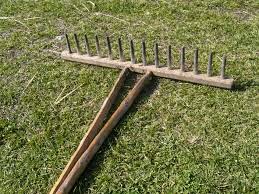Sunday, December 21, 2014
drilling machine
As another Lame Cherry exclusive in matter anti matter.
In 1800's America, there was something in vogue which was of perfect sense in drilling machines and for reasons I can not fathom the modern PBS thieves have not plagiarized this idea, nor more than any of these garden tool companies in their rackets of expensive tools.
I honestly too dismissed them when mentioned in Bruist's Kitchen Garden, but giving up being brain sloven, I endeavored to consider this implement and how really necessary it is.
"While I leave the gardener to make his own choice of tools, I would suggest that he be provided with two or three drilling machines; these, every handy man can make for himself; they should be in the form of a garden-rake, with a stout, heavy back, and five teeth, about two inches broad, and tapered so as to enter the ground and leave drills two inches deep.
If one be made with the teeth eight inches apart, another twelve, and another fourteen, they will be useful in making drills for the various kinds of seed; and drills thus made serve instead of straining a line when transplanting Cabbage, Lettuce, Leek plants, etc.; the line being stretched at one edge of the bed, and the drilling machine drawn straight by the line, makes five drills at once. If they are straight, they may be kept so, by keeping one drill open for the outside tooth to work in, until the ground be all drilled."
Bridgeman, Thomas d. 1850. The American Kitchen-Gardener
The problem I have with this drilling machine, which is just a rake with wide teeth is with 15 inch teeth we are dealing with a rake around 64 inches in width, leaving room for the outside teeth.
That is a rather large implement to store and deal with.
On lesser scales a three tooth drilling machine would be half that width.
The idea in this is 2 inches deep, and 1 inch soil covering, so it leaves a row with a slight depression for watering the seeds before, during and after germination......and of course to mark for weeding in the event of a late sprouting.
There are all sorts of caveats in this though, in the dirt must be pulverized, so the drill will not be bouncing about being pulled. My dirt tends to have clay clumps in it hard as rocks at times. It is a place I am working in rejuvenating as I remember the spot being where a 450 International tractor was parked, which often was a path to drive on, and that had 6 feet tall rag weeds or vines of low mallow on it.
The ground behaves when wet, but when dry it comes out in chunks, even with manure and mulching.
What I am thinking in this drilling machine of my invention, is all metal. I like the idea of dulled sickle teeth for a grass mower that farmers use. These would be welded or bolted into place.
These teeth are tapered to a point, made of 1/8th inch steel, and already have two holes at the top to rivet in place....so I suppose I could rivet them in place too, into an inch by inch angle iron, of the current not too heavy grade in hardware stores.
I prefer a inch steel or galvanized pipe. Yes I can weld galvanized pipe even if they say it can not be done. This pipe would then be welded in a T to the angle iron which holds the teeth.
To make it stable, I would spot weld a 3/8ths inch rod to the angle iron ends to the handle.
That would seem to get it there and back without it falling apart due to undo stress in have a lawnmower run over it, or your 300 pound neighbor wandering about your garden packing it all down like a herd of cattle.
I suppose I could market this, but no one would know what it would be for, as people are lazy in liking their hoes to do the work as I always do it, with my crooked as the winding river rows. I simply figure that with crooked rows, I get more crop in the ground.......at least that is what I tell people who mock my figurative rows.
That is the idea for those not in raised beds who have long carrot, beet, lettuce and whatever rows. I can not do raised beds as there is not enough water in the Great Lakes to grow a crop in arid lands with raised beds....why hills never work out as they are nothing but dust dunes in the wind.
Well enough of this invention business.
agtG


